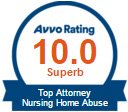Risk Factors for Malnutrition in Nursing Homes
The risk factors for malnutrition in nursing homes relate to patients’ physical and mental conditions as well as the quality of care provided by nursing home staff. For example, each of the following can increase a resident’s risk of experiencing malnutrition:
- Chronic illnesses and use of certain prescription medications
- Suffering from Alzheimer’s disease or another form of dementia
- Being unable to feed oneself, and being reliant on nursing home staff for all meals
- Insufficient staffing at the nursing home, resulting in nurses having responsibility for too many residents’ needs
- Employment of nurses and caregivers who are not knowledgeable about nutrition and the risks of malnutrition
Symptoms of Malnutrition
Elderly nursing home residents who are not receiving adequate nutrition can begin to experience symptoms within as little as a few days. These symptoms can worsen over time, and malnutrition can have a variety of potentially-dangerous complications as well. Some of the early warning signs of malnutrition include:
- Difficulty breathing
- Dry skin
- Feeling cold
- Feeling tired and persistently fatigued
- Irritability
- Loss of body fat
- Slowed recovery from illnesses and infections
As these symptoms progress and a resident’s lack of adequate nutrition continues, malnutrition can lead to complications including:
- Depression
- Heart, liver and respiratory failure
- Higher risk of complications during surgery
- Higher risk of hypothermia
- Muscle weakness (which can lead to falls and other accidents)
- Unresponsiveness
- Weakened immune system


















